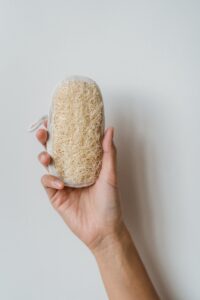Which is the Better Option?

When it comes to exfoliating your skin during a bath or shower, you may find yourself debating between two common options: bath sponges and loofahs. Both of these tools are designed to gently scrub away dead skin cells, leaving you with smooth, glowing skin. However, there are some key differences between bath sponges and loofahs that may make one option a better fit for your needs.
So Which Option Is the Better Choice?
Bath sponges are typically made from synthetic materials like polyester or nylon, and they often come in bright colors and fun shapes. They are designed to create a rich lather and gently exfoliate the skin without causing irritation or damage. Bath sponges are easy to use and can be a great choice for people with sensitive skin.
On the other hand, loofahs are made from the fibrous skeleton of a vegetable called the loofah gourd. They have a rough texture that can be more effective at removing dead skin cells and smoothing rough patches of skin. Loofahs are also naturally antibacterial and biodegradable, making them a more eco-friendly option than synthetic bath sponges.
So which option is the better choice? It ultimately depends on your personal preferences and needs. Here are a few factors to consider when choosing between a bath sponge and a loofah:
Skin Sensitivity
If you have sensitive skin or are prone to irritation, a bath sponge may be the better choice. Bath sponges are designed to be gentle and non-abrasive, so they are less likely to cause redness or discomfort. However, if you have tougher skin and want a more intense exfoliation, a loofah may be a better option.
Ease of Use
Bath sponges are typically easier to use than loofahs. They are soft and pliable, making it easy to create a rich lather and get into hard-to-reach areas. Loofahs, on the other hand, can be stiff and hard to maneuver, which can make them more challenging to use.
Environmental Impact
If you are concerned about reducing your environmental impact, a loofah may be the better choice. Since they are made from a natural, biodegradable material, they are a more eco-friendly option than synthetic bath sponges. However, if you do choose to use a synthetic bath sponge, be sure to dispose of it properly and avoid contributing to plastic pollution.
Longevity
Bath sponges typically last for a few weeks to a few months before needing to be replaced. Loofahs, on the other hand, can last for several months if cared for properly. Be sure to rinse your loofah thoroughly after each use and allow it to dry in a well-ventilated area to prevent bacterial growth.
Ultimately, the choice between a bath sponge and a loofah comes down to your personal preferences and needs. If you have sensitive skin and want a gentle exfoliation, a bath sponge may be the better choice. If you want a more intense exfoliation and are concerned about reducing your environmental impact, a loofah may be the way to go.

Get the Most Out of Your Exfoliation
Regardless of which option you choose, there are a few tips to keep in mind to ensure that you are getting the most out of your exfoliation routine. First, be sure to wet your sponge or loofah thoroughly before use. This will help to soften the fibers and make it easier to use. Next, use a gentle touch and avoid scrubbing too hard, as this can lead to irritation or damage to the skin. Work the sponge or loofah in circular motions, starting from your feet and working your way up. Finally, rinse your sponge or loofah thoroughly after use and allow it to dry in a well -ventilated area to prevent bacterial growth.
Not All Loofahs Are Equal
If you do decide to use a loofah, it’s important to note that not all loofahs are created equal. Some loofahs on the market are actually made from synthetic materials that mimic the texture of natural loofahs. Be sure to read the label carefully and choose a loofah made from 100% natural loofah fibers.
You Should Replace Your Bath Sponge or Loofah
Another thing to consider is how often you should replace your bath sponge or loofah. As mentioned earlier, bath sponges typically last for a few weeks to a few months before needing to be replaced, while loofahs can last for several months. However, if you notice that your sponge or loofah is starting to smell, feel slimy, or look discolored, it’s time to replace it. These are signs that bacterial growth has occurred and using the sponge or loofah could lead to skin irritation or infection.
In conclusion, both bath sponges and loofahs can be effective tools for exfoliating the skin and leaving you with a smoother, brighter complexion. When choosing between the two, consider factors such as skin sensitivity, ease of use, environmental impact, and longevity. Regardless of which option you choose, be sure to use a gentle touch and follow proper hygiene practices to ensure that you are getting the most out of your exfoliation routine.

